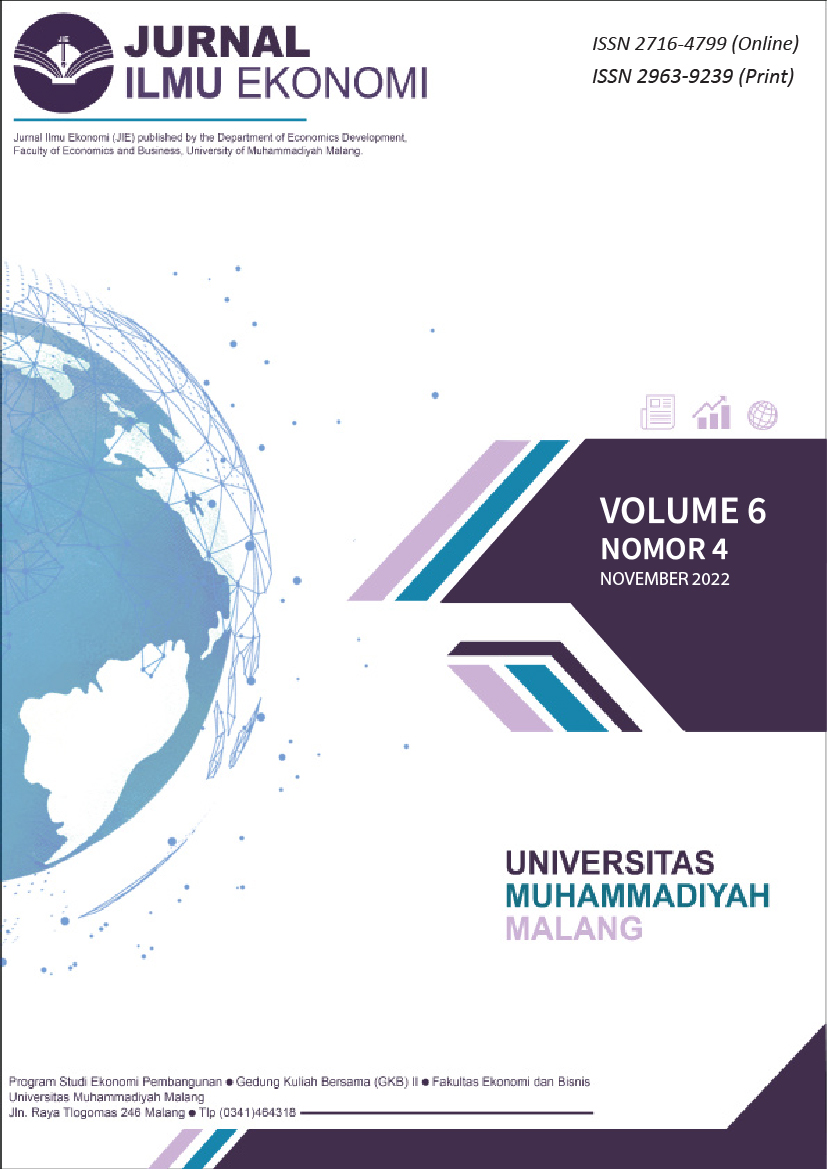Analisis Indeks Keparahan Kemiskinan di Pulau Jawa 2012-2021
DOI:
https://doi.org/10.22219/jie.v6i4.23011Keywords:
Proverty, Education, Health, Unemployment, Panel RegressionAbstract
The purpose of this study was to analyze the poverty severity index on the island of Java in 2012-2021. The data analysis method used is a combined panel data analysis of time series and cross-section. The analysis used to see the effect of the independent variables, namely the Average Length of Schooling, Life Expectancy and the Open Unemployment Rate. Poverty Severity Index as the dependent variable. From the results of the study, it can be concluded that the variables of Life Expectancy and Open Unemployment have a positive and significant effect on the Poverty Severity Index. Meanwhile, the average length of schooling has no significant effect on the Poverty Severity Index in Java.
Tujuan dari penelitian ini adalah untuk menganalisis indeks keparahan kemiskinan di pulau jawa Tahun 2012-2021. Metode analisis data yang di gunakan adalah analisis data panel gabungan time series dan crossection. Analisis yang digunakan untuk melihat pengaruh variable independent yaitu Rata-rata Lama Sekolah, Angka Harapan Hidup dan Tingkat Pengangguran Terbuka.Indeks Keparahan Kemiskinan sebagai variable dependent. Dari hasil penelitian dapat di simpulkan bahwa variable Angka Harapan Hidup dan Tingkat Pengangguran Terbuka berpengaruh positif dan signifikan terhadap Indek Keparahan Kemiskinan. Sedangkan Rata-rata Lama Sekolah tidak berpengaruh signifikan terhadap Indeks Keparahan Kemiskinan di Pulau Jawa.
Downloads
References
Athadena, E. D. (2021). Analisis Pengaruh Tingkat Pendidikan , Kesehatan dan Pengangguran terhadap Kemiskinan di Provinsi Sumatera Barat Periode 2011-2020. Jurnal Ilmiah Mahasiswa FEB Universitas Brawijaya, 9(2), 24–25. https://jimfeb.ub.ac.id/index.php/jimfeb/article/view/7751
Azizah, E. W., Sudarti, & Kusuma, H. (2018). Pengaruh Pendidikan, Pendapatan perkapita dan Jumlah Penduduk Terhadap Kemiskinan di Provinsi Jawa Timur. Jurnal Ilmu Ekonomi, 2(1), 167–180.
Badan Pusat Statistik. (n.d.). Jumlah Penduduk Pertengahan Tahun (Ribu Jiwa), 2020-2022. https://doi.org/10.1055/s-2008-1040325
Dama, H. Y., Lapian, A. L. C., & Sumual, J. I. (2016). Pengaruh Produk Domestik Regional Bruto (Pdrb) Terhadap Tingkat Kemiskinan Di Kota Manado (Tahun 2005-2014). Jurnal Berkala Ilmiah Efisiensi, 16(3), 549–561.
Fatorrohim, R. (2011). Pengaruh PDRB , Harapan Hidup dan Melek Huruf Terhadap Tingkat Kemiskinan. Universitas Islam Negeri Syarif Hidayatullah.
Handayani, A. (2018). Pengaruh Tingkat Pendidikan, Kesehatan Dan Pengangguran Terhadap Tingkat Kemiskinan Di Kabupaten Bojonegorotahun 2002 -2015. Jurnal EKBIS, 19(1), 1024–1038.
Harlik, Amir, A., & Hardani. (2013). Faktor-Faktor yang Mempengaruhi Kemiskinan dan Pengangguran di Kota Jambi. Jurnal Perspektif Pembiayaan Dan Pembangunan Daerah, 1(2), 109–120. https://online-journal.unja.ac.id/JES/article/view/1500
Monang, S. Tambun, J., & Bangun, R. (2018). Pemodelan Faktor-Faktor yang Mempengaruhi Indeks Kedalaman Kemiskinan dan Indeks Keparahan Kemiskinan Kabupaten/Kota di Sumatera Utara Menggunakan Regresi Data Panel. Publikauma : Jurnal Administrasi Publik Universitas Medan Area, 6(1), 100. https://doi.org/10.31289/publika.v6i1.1574
Muqodim. (2019). Pengaruh Kepemilikan Institusional, Leverage, dan Ukuran Perusahaan Terhadap Penghindaran Pajak(Studi Empiris pada Perusahaan Property dan Real Estate yang Terdaftar di BEI Tahun 2014-2018). Journal Unuversitas Islam Indonesia, 40–48.
Pintowati, W., & Otok, B. W. (2012). Pemodelan Kemiskinan di Propinsi Jawa Timur dengan Pendekatan Multivariate Adaptive. Jurnal Sains Dan Seni ITS, 1(1), D283–D288. http://www.ejurnal.its.ac.id/index.php/sains_seni/article/view/2072
Pratama, Y. C. (2015). Analisis Faktor-Faktor Yang Mempengaruhi Kemiskinan Di Indonesia. Esensi, 4(2), 210–223. https://doi.org/10.15408/ess.v4i2.1966
Putra, I. K. A. A., & Arka, S. (2016). Analisis Pengaruh Tingkat Pengangguran Terbuka, Kesempatan Kerja, Dan Tingkat Pendidikan Terhadap Tingkat Kemiskinan Pada Kabupaten / Kota Di Provinsi Bali. E-Jurnal EP Unud, 7(3), 416–444.
Rusdarti, & Sebayang, R. K. (2019). Faktor-Faktor Yang Mempengaruhi Tingkat Kemiskinan di Provinsi Jawa Timur. E-Journal Ekonomi Bisnis Dan Akuntansi, 9(1), 1–9. https://doi.org/10.19184/ejeba.v6i1.11108
Segoro, W., & Pou, M. A. (2012). Analisis Pengaruh Produk Domestic Regional Bruto (PDRB), Inflasi, Indeks Pembangunan Manusia (IPM) Dan Pengangguran Terhadap Kemiskinan Di Indonesia Tahun 2019-2012. SNapp2016 Sosial, Ekonomi, Dan Humaniora, 28–34.
Suryawati, C. (2005). Memahami Kemiskinan Secara Multidimensional. JMPK, 08(03), 121–129.
Zuhdiyaty, N., & Kaluge, D. (2018). Analisis Faktor - Faktor Yang Mempengaruhi Kemiskinan Di Indonesia Selama Lima Tahun Terakhir. Jurnal Ilmiah Bisnis Dan Ekonomi Asia, 11(2), 27–31. https://doi.org/10.32812/jibeka.v11i2.42
Downloads
Published
How to Cite
Issue
Section
License
Copyright (c) 2022 Taufiqurrahman, M.

This work is licensed under a Creative Commons Attribution-NonCommercial-ShareAlike 4.0 International License.
Authors who publish with this journal agree to the following terms:
- For all articles published in the JIE (Jurnal Ilmu Ekonomi), copyright is retained by the authors. Authors give permission to the publisher to announce the work with conditions. When the manuscript is accepted for publication, the authors agree to the automatic transfer of non-exclusive publishing rights to the publisher.
- Authors retain copyright and grant the journal right of first publication with the work simultaneously licensed under a Creative Commons Attribution-NonCommercial-ShareAlike 4.0 International License that allows others to share the work with an acknowledgement of the work's authorship and initial publication in this journal.
- Authors are able to enter into separate, additional contractual arrangements for the non-exclusive distribution of the journal's published version of the work (e.g., post it to an institutional repository or publish it in a book), with an acknowledgement of its initial publication in this journal.
- Authors are permitted and encouraged to post their work online (e.g., in institutional repositories or on their website) prior to and during the submission process, as it can lead to productive exchanges, as well as earlier and greater citation of published work (See The Effect of Open Access).
This is an open access article and licensed under a Creative Commons Attribution-NonCommercial-ShareAlike 4.0 International License








